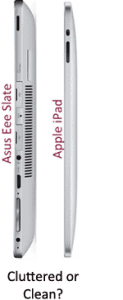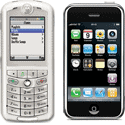This is part two of a three part series on the strategy behind the integrated product, service and content platforms that forge the Apple Fortress. In Part I-Pacing Profits Beyond Platforms, we defined the three cornerstones behind Apple’s transformation:
1. Pacing for Profits – Apple sets a deliberately moderate pace that extracts disproportionate profits while simultaneously creating demand “tension” in the marketplace.
2. Create Compelling Customer Experience – Apple platforms create new customer experiences whereas competitors aggregate existing best practices.
3. Passion for Minimalist Perfection – If there is a “secret sauce” that Steve Jobs personally infused into the company, it is his passion for minimalist design and perfection.
The Visceral Moment of Experience
 Take a look at the Asus tablet vs. the iPad. It screams functionality with it’s ports, doors and grill. This is a machine and you better know what plugs in where. Now look at the iPad. It says pick me up; turn me on.
Take a look at the Asus tablet vs. the iPad. It screams functionality with it’s ports, doors and grill. This is a machine and you better know what plugs in where. Now look at the iPad. It says pick me up; turn me on.
In this piece, we’ll address #2 from above and show how Apple stands apart from the crowd by inventing new customer experience platforms. We will address four factors:
- Inventing New Experiences vs. What Customers Already Do
- An Aware and Demanding Eye
- Inventing From the Outside-In
- Controlling the User Experience
1. Inventing New Experiences vs. What Customers Already Do
At IBM, Thomas Watson made “Think” an iconic motto. Shortly after Steve Jobs return to Apple in 1997, Apple introduced a new ad campaign “Think Different”. Nothing describes Apple’s unique approach to customer experience better.
Designing for customer experience has evolved from an art to a science. At the Stanford Institute of Design (the d.school), students are taught the techniques of user-centered design. But as Don Norman, a former Apple vice-president and Breed Professor of Design, Emeritus, at Northwestern explains, that doesn’t explain Apple
I’ve been thinking hard about the Apple product-development process since I left. If you follow my [guidelines], it will guarantee good design. But Steve Jobs doesn’t want good design. He wants great design, and my method will never give you that.
It’s important to distinguish inventing a new customer experience from inventing a new technology. People credit Xerox’s legendary Palo Alto Research Center (PARC) for creating the graphic user interface and mouse that made the Macintosh famous. Apple took Xerox’s laboratory technology and invented the combination of hardware packaging (i.e. the Macintosh) and software (i.e. the Mac operating system and programs) that created a commercial user experience.
Inventing experience underlies every aspect of Apple’s platforms, including retail. When Apple decided to open their own retail stores, the computer was evolving from a productivity machine to a hub for entertainment, video, music, information, etc. Apple board member and GAP CEO Mickey Drexler suggested that they build a prototype store first; just as they would start with a prototype in a traditional hardware project.
Built in an empty warehouse near the Apple campus using higher grade materials than one might normally find in a computer retail store, the first prototype store still looked like most others. It was organized by product, software and accessories such that it mimicked the way the company was organized. This is rarely how customers think or buy. When Apple’s retail leader, Ron Johnson walked through it with Steve Jobs, they exclaimed, “Oh, God, we’re screwed!”
In the next iteration of the store, only a quarter of the store was devoted to product. The left wall was organized by interests (video, music, etc.), the right wall was devoted to problems and a new area, the Genius Bar, was added.
Rapid prototyping is essential when inventing a new experience. Customer experience is a visceral reaction fueled by sensory data. Color, position, sound and shape all combine and are rapidly matched against expectations and experience. Focus groups can tell you what customers know they expect but they won’t tell you what customers don’t expect. As Henry Ford said, if had asked potential Model T customers what they wanted, they would have asked for faster horses.
The Genius Bar resulted from research Apple did on the best service examples that customers could identify. Surprisingly, 16 of 18 identified concierge services at luxury hotels such as The Four Seasons – hence the Genius Bar; a concierge service for Apple users. Again, Apple didn’t invent the concierge concept but they did invent applying it to retail.
2. An Aware and Demanding Eye
Inventing new customer experiences requires a deep understanding of what customers are trying to achieve and how they really behave. Rather than asking questions, one can learn a great deal by observing them solving problems, seeing the tools they use and most importantly, how they use them. Steve Job’s keen eye and personal interest in design introduced what design schools now call “observational studies” into Apple’s DNA as early as the Macintosh.
During the development of the Mac’s graphics software, what today are low level expectations for any computer user were a series of small breakthroughs. One morning, Bill Atkinson, the father of QuickDraw and MacPaint, proudly demonstrated how he could get the Mac to draw ovals rapidly. Keep in mind that onboard memory and processor power was such a scarce resource such that seemingly simple tasks were a significant challenge.
As ovals swept across the screen, Jobs asked Atkinson if he could get the Mac to draw rectangles with rounded corners just as quickly. Atkinson was taken aback. Why weren’t square corner rectangles sufficient?
Jobs pointed out all the objects in the room around them that had rounded corners. He then pushed Atkinson to take a walk with him outside as he pointed out more “rounded rects” that permeate our lives. Finally when Atkinson saw a No Parking sign in front of Apple, he gave in. The next morning Atkinson came in with a routine that could draw rounded rectangles as quickly as ovals. If you want to see how much we have come to expect rounded rects, just look at your iPhone and iPad keyboards!
When Apple combines their demanding eye with patience as detailed in Part I: Pacing Profits Beyond Platforms, it stops them from pursuing new platforms until they can invent a new experience.
 Do you remember the Apple-Motorola partnership that spawned the 2005 ROKR cell phone? Most don’t as the product was a dismal failure. The ROKR was touted as an “iPod shuffle on your phone”. It looked like traditional cell phone but only held 100 songs and couldn’t download music directly. In a subsequent interview with the Wall St. Journal’s Walt Mossberg, Jobs revealed that Apple didn’t consider doing their own phone until he saw the gesture technology Apple engineers developed for a potential tablet. Once he saw that, he knew Apple could invent a new cell phone experience that stood above all competitors.
Do you remember the Apple-Motorola partnership that spawned the 2005 ROKR cell phone? Most don’t as the product was a dismal failure. The ROKR was touted as an “iPod shuffle on your phone”. It looked like traditional cell phone but only held 100 songs and couldn’t download music directly. In a subsequent interview with the Wall St. Journal’s Walt Mossberg, Jobs revealed that Apple didn’t consider doing their own phone until he saw the gesture technology Apple engineers developed for a potential tablet. Once he saw that, he knew Apple could invent a new cell phone experience that stood above all competitors.
3. Inventing From the Outside-In
The example of Apple retail experience development shows that looking at any design through a customer experience lens changes your point of view. In a nutshell, the trajectory to invent a new customer experience starts from the outside and moves inward as it defines what and how the guts of a product or service must come together.
Starting from the outside rapidly blurs traditional distinctions between hardware and software. When the customers’ experience drives design, people are motivated to communicate and design concurrently with far less regard to their organizational roles and position. Software development influences hardware design rather than waiting until the hardware is stable enough to support software development.
Outside-in thinking also blurs the boundaries between product and service as well as forcing people to think internationally. Icons rather than words dominate Apple products and service design because they speak to all cultures and countries. The requirements for an insanely great music experience requires easy to carry hardware (e.g. iPod) and a way to legally buy, store, load and create personal playlists (iTunes).
The Apple Fortress came about because to make iTunes work, the music industry had to buy into using Apple as their first step in legal, digital distribution. This ultimately caused Apple to drop the word “Computer” from their name in 1997 as they became a major power in digital distribution of all forms of media.
The implications of outward-in design bleed into every aspect of Apple. As I noted in Understanding Customer Experience:
A customer’s experience with an Apple device begins well before the purchaser turns it on—in the case of the iPod, perhaps with the dancing silhouettes in the TV advertisements. The origami-like (and recyclable) packaging enfolds the iPod as though it were a Fabergé egg made for a czar. A small sticker, “Designed in California, Made in China,” communicates the message that Apple is firmly in charge but also interested in keeping costs down. Even Windows users appreciate the device’s intuitive, Mac-like feel and find that downloading tracks from iTunes is easier than buying a CD on Amazon. Every Apple product is designed with the overarching purpose of making the time one spends with Apple an enjoyable experience.
4. Controlling the Experience
The motivation that keeps Apple designs closed and tightly controlled is customer experience. As soon as one opens a system to connections of consequence, including software add-ons that carriers add to most Android-based cell phones, the potential for conflicts and unintended interactions increases. Only the Mac Pro workstation has traditional expansion slots for additional cards. The rest of Apple platforms are closed.
Apple treats their designs as one would art. Just as you wouldn’t want to alter a brush stroke on a Matisse painting, Apple doesn’t want you, or cellular carriers, messing with their designs. By controlling hardware, software and service from end-to-end, Apple minimizes alterations that might diminish customer experience.
Open system advocates such as Google would argue Apple’s approach is an editorial stick that constrains users’ freedom of choice. Apple sees their sense of style as a carrot that attracts users because it focuses attention on that which matters most. In the Apple world, less is more and they cite the sales and extraordinary loyalty they evoke. While not everyone’s cup of tea, it’s hard to argue with their success.
Summary – “I don’t Know Much About Art, But I Know What I Like”
If one looked at Apple, particularly over the last five years, one could mistakenly think that inventing customer experience platforms is a low-risk strategy. The platforms that fortify the Apple fortress stand on the shoulders of past failures. Without the $10,000 Lisa, we would not have today’s sub $1,000 Mac. Besides the well-known failure of the Newton, there was also the Pippin, eWorld and the Bang & Olufsen look-a-like 20th Anniversary Mac.
Artists that we hold in high acclaim today were often ridiculed in their time. That’s the essence and risk of “Think Different”. Stepping outside the norm requires the same boldness that led Andy Warhol to take 32 Campbell soup cans off the supermarket shelf and bring them into our living rooms. Dennis Hopper was the first of a half dozen to pay $100 for a canvas.
Without artistry, Apple wouldn’t be Apple. Is it not surprising that the embossed inside the back cover of the original Macintosh are the signatures of the development team? Apple’s passion for minimalist perfection cuts across products, services and content…and will be the focus of our final post in this series. Stay tuned.

 I'm Christopher Meyer - author of Fast Cycle Time, Relentless Growth and several Harvard Business Review articles.
I'm Christopher Meyer - author of Fast Cycle Time, Relentless Growth and several Harvard Business Review articles. 
Great post!
Also of interest is this recent post: https://www.instituteofcustomerservice.com/1711-6870/Apple-intangibles-and-profit.html
which highlights some of the mistakes Apple makes which due to its customer experience it can nonetheless get away with.